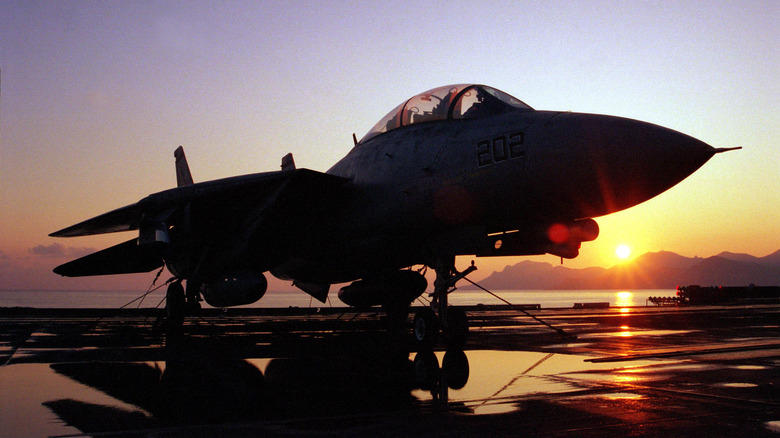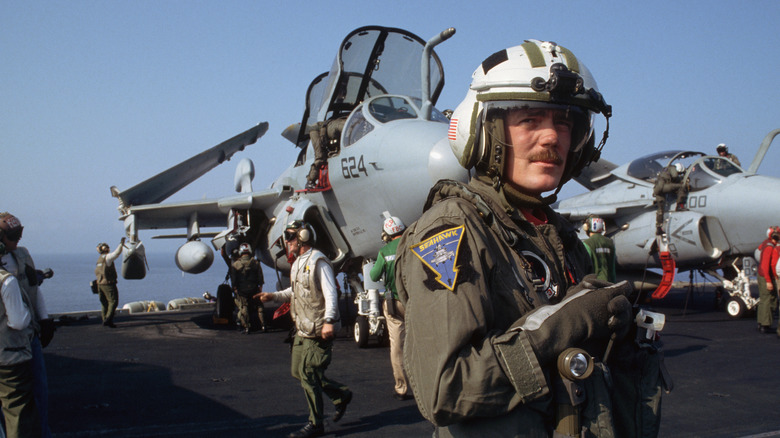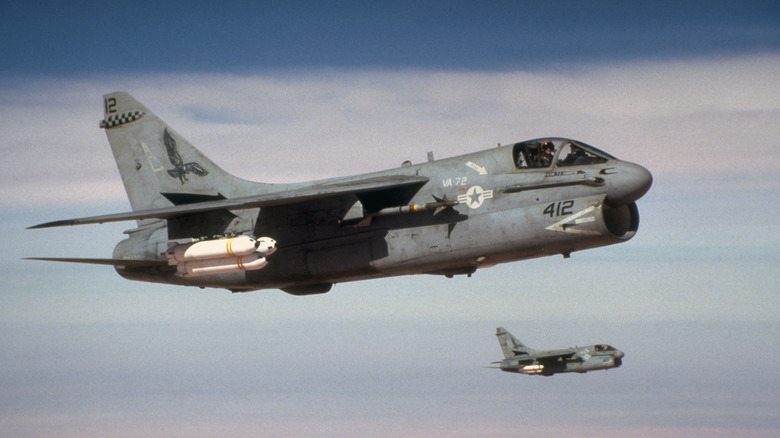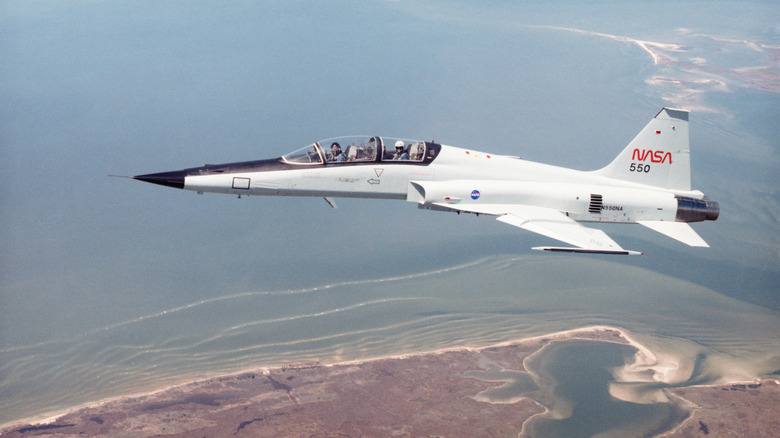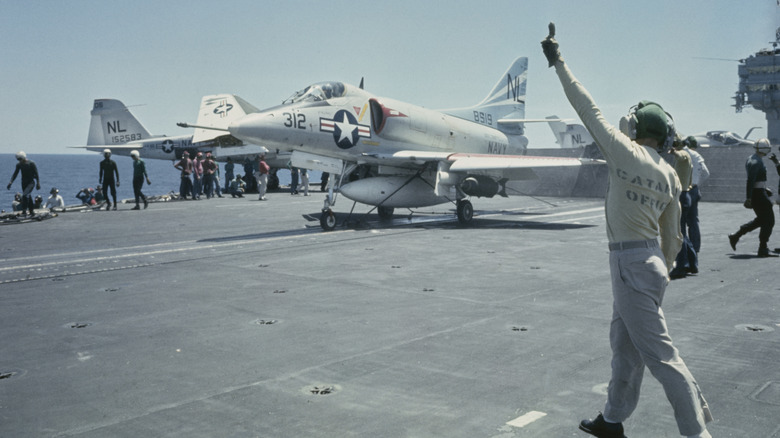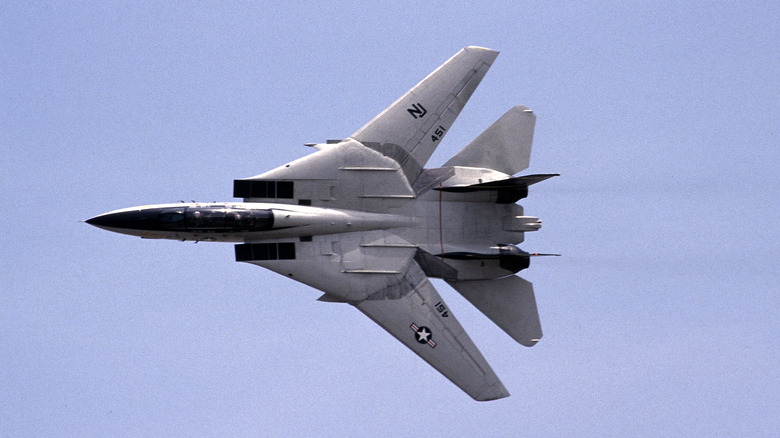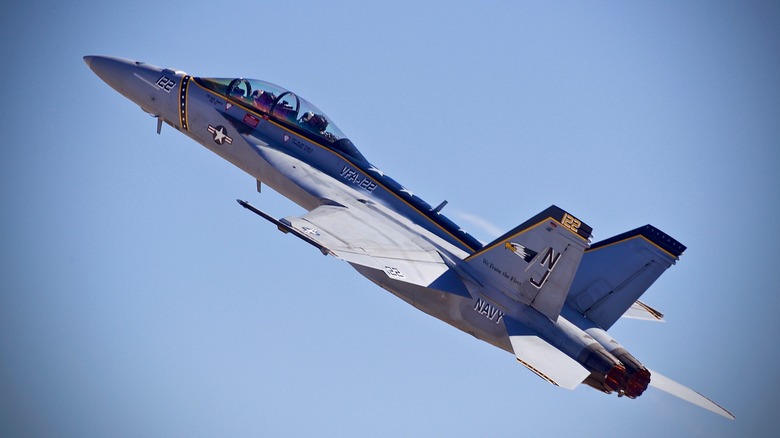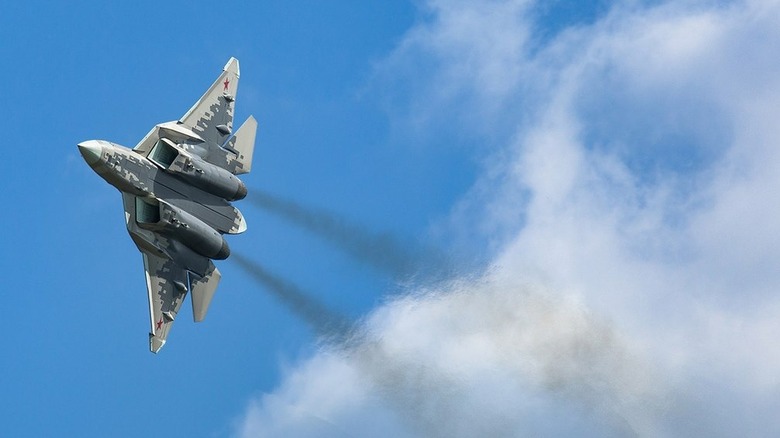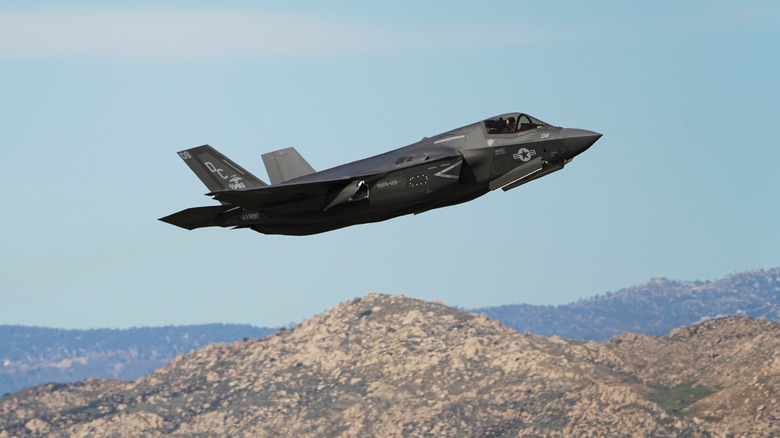Every Fighter Jet Featured In Top Gun, Ranked Worst To Best
The "Top Gun" franchise has caught the imagination of moviegoers spanning several generations, thanks in no small part to its highly realistic aerial combat scenes and Tom Cruise's Dorian Gray-like aging process. While his protagonist carries the films as elite fighter ace Pete "Maverick" Mitchell, it could be argued that the multiple fighter jets steal the show, with the original movie making a household name of the F-14 Tomcat and, lately, the F-18 Super Hornet with its sequel, "Top Gun: Maverick."
Directed by the late Tony Scott, the original "Top Gun" movie placed Cruise firmly on the map as a Hollywood A-lister and, despite a somewhat shaky script that leans heavily on cliché, is still a firm favorite among film fans. It was, therefore, a pleasant surprise when, 36 years later, he and Jerry Bruckheimer reprised their star/producer roles and, in doing so, created one of the most successful film sequels of all time, that currently rides high on the list of global box office takings at around 1.5 billion dollars.
While the script for "Top Gun: Maverick" is more refined as compared to the original, it continues to rely on the military aviation technology of the past and present to bring its story to life in the testing, training, and combat sequences, and these are the scenes that stick in the memory when we think of "Top Gun." Here we rank all the fighter jets featured in the movie franchise that saw actual military service, considering their technology, armaments, performance, and influence.
8. Grumman A-6 Intruder
The A-6 intruder was created after the Korean War, as the U.S. Navy saw a demand for an agile subsonic strike aircraft that was effective at low altitudes. This new plane had to combine long range with a large payload and low weight, and it had to be able to operate at high speeds while flying close to rooftop level in order to evade detection by enemy radar.
Grumman won the contract with a twin-engine design that featured jets at the fuselage below each wing. Its snub-nosed profile had a wide enough cockpit to facilitate side-by-side seating for the aircrew, while a navigator sat behind. Not only was the design practical in terms of its seating arrangement, but its large nose cone housed much of its military technology.
This onboard tech included an advanced radar system and a digital computer system that operated a CRT display to assist bomb targeting and navigation, all of which were highly advanced for a plane that first flew in 1960. The A-6 Intruder was operational for over four decades, with its last major conflict being Desert Storm in 1991. It was a valued member of the U.S. fleet, although it got little love from crewmembers, who used to give it the nicknames "Iron Tadpole" and "Flying Drumstick" on account of its bulbous appearance.
The A-6 intruder only features fleetingly in "Top Gun." As the credits roll, some can be seen grounded on the carrier's deck, so it cannot be viewed as integral to the movie. However, it is worthy of mention in this ranking as an essential addition to the U.S. Navy, and a capable and advanced fighter that was almost half a century in development and combat.
7. Ling-Temco-Vought A-7 Corsair II
In the early 1960s, the U.S. Navy saw the need for a long-range attack aircraft that could carry heavy payloads. One stipulation at the time of its creation was that it must have more accurate weaponry than its predecessor, the A-4 Skyhawk, as there was significant wastage. Several experienced companies bid for the contract, including Grumman and Douglas, but Ling-Temco-Vought won with the A-7 Corsair II, which was based on Vought's existing F-8 Crusader design, to further reduce costs.
First deployed to provide close air support for troops during the Vietnam War, these aesthetically-challenged jets were characterized by their large air intakes below the nose cone. This fed the turbofan engine that gave markedly better fuel economy, even with a full complement of twelve 500-pound bombs. Its main gun was a single M61A1 Vulcan 20mm rotary cannon with 1,030 rounds, and it also carried missiles and rockets as part of its payload, which combined to give a maximum takeoff weight of just under 42,000 pounds.
The U.S. Navy and Air Force retired the A-7 Corsair II in 1991, but it was still in use by the Portuguese until 1999, with the last jet retired by the Hellenic Air Force of Greece in 2014. Like the Grumman A-6 Intruder, we never saw the A-7 fly in either "Top Gun" movie, but several appeared on the deck of the USS Enterprise aircraft carrier in the first film as part of the Navy fleet.
6. Northrop F-5
You may remember the Mig-28 aircraft piloted by the Russians in the original "Top Gun" movie; however, these were fictional and were actually U.S.-made Northrop F-5 planes. Despite being designed over 20 years before the movie's 1986 release, this supersonic, highly maneuverable fighter was still a more-than-capable adversary to the modern F-14 Tomcats of the elite TOPGUN squadron.
In the late 1950s, there was a requirement for an affordable fixed-wing aircraft to serve the U.S. and its allies, and it had to be lightweight and operational from the smaller World War Two-era escort carriers. The result was a lean fighting machine that used a General Electric J85 turbojet engine with an impressive thrust-to-weight ratio. While it had a shaky start as the N-156F, the Cold War came about, and soon it was renamed the F-5 by the U.S. Air Force, mass-produced under contract during the Kennedy administration. From that moment on, the Northrop F-5 enjoyed global success, with production licensed out to 20 air forces worldwide, and it has seen considerable action since its unveiling in 1963, particularly during the Vietnam War, where the F-5 squadron was dubbed the "Skoshi Tigers."
The enduring quality and excellent performance of the Northrop F-5 are evidenced by the fact that it is still in use, mainly as a training aircraft before pilots graduate to more modern fighters such as the F-16 and F-18. Despite its relaxed combat role, the F-5 is still an important player in the annals of military aviation, and it still looks impressive in "Top Gun," even by today's standards; hence it ranks sixth on this list.
5. Douglas A-4 Skyhawk
Some of us may be familiar with the A-4 Skyhawk as the chosen aircraft of the Blue Angels before the McDonnell Douglas F/A-18 Hornet succeeded it. Notable for its simplicity, the compact fighter was produced in the early 1950s as a delta-wing alternative to folding-wing planes for use on aircraft carriers. Its scaled-down dimensions led to it being dubbed the "Tinker Toy" by Navy crew, and the plane saved on weight as well as size, thanks to a wind-driven generator in place of a heavy battery and a gravity-activated landing gear that eliminated the need for hydraulics.
The Douglas A-4 Skyhawk was used during training maneuvers in the first "Top Gun" movie as the dummy "enemy" aircraft, and is present in many key scenes. These include the pivotal moment where Maverick's wingman, Nick "Goose" Bradshaw, is killed as he failed to properly eject from his F-14, while chasing an A-4 Skyhawk down as it simulated a Russian MiG. However, the Skyhawk was much more than a film prop, as these were the actual planes used for training by TOPGUN at its Naval Air Station in Miramar, California.
The A-4 Skyhawk saw plenty of service during its 51-year tenure before it was retired in 2003. Over 3,000 were produced in 23 years before 1979, and it was used as an aggressor aircraft in the Falklands War and the Arab/Israeli Wars, although it saw most action during the Vietnam War. A total of 195 Skyhawks were shot down over Vietnam, including the one piloted by Senator John McCain. Its prominent role in "Top Gun" and historical importance place the Douglas A-4 Skyhawk fifth in this ranking.
4. Grumman F-14 Tomcat
As "Maverick" Mitchell's main fighter in the original movie, the Grumman F-14 Tomcat was a product of the Cold War, designed to combat the looming threat of the ever-developing Soviet long-range aircraft. This agile sweep-wing aircraft was heavily laden with Phoenix air-to-air missiles, effective at various speeds with a full payload, and could engage the enemy from afar. It also became the pin-up of fighter jets, adorning posters in bedrooms across the world, following the success of the first "Top Gun" movie in the mid-1980s.
By the time Pete "Maverick" Mitchell first set foot in an F-14, the "Tomcat" was over a decade old, having first been delivered in 1972. However, it didn't see its first aerial combat until 1981, when it downed two Libyan fighter jets, before featuring in the Gulf War, Iraq War, and Afghan War. This was a dual-seater, with room for a pilot and a radar intercept officer (as played by "Maverick" and "Goose," respectively). Its stats remain impressive, even by today's standards, with a maximum speed of over 1,500 miles per hour and a climb rate of 30,000 feet per minute, up to a ceiling of 55,000 feet.
The F-14's sweep wing design provided extra lift for short takeoffs and landings when extended, and would tuck in for a more aerodynamic profile at supersonic speeds. When pushed during test flights, it could achieve Mach 2.5, a rate that would give even modern fighter jets like the F-35 a run for their money. It is the plane most closely associated with "Top Gun," and it featured in both films, placing the Grumman F-14 Tomcat highest among the Cold War-era planes in this ranking.
3. Boeing F/A-18 Super Hornet
Just like Val Kilmer's "Ice Man," the F-14 Tomcat was honorably retired. Its successor, piloted by the elite fighter aces in the "Top Gun: Maverick" mission, was the Boeing F/A-18 Super Hornet. As a modern tactical strike aircraft, it has superior firepower that includes the aptly-named Maverick missiles, a 20mm cannon, IM 9 Sidewinder and AIM 7 Sparrow missiles, and the Paveway laser-guided bomb.
The "Super Hornet" expanded upon previous generations of "Hornet" aircraft, with the latest version being 15,000 pounds heavier with a full payload, and able to carry 33% more fuel, extending its range considerably. It first saw action in 2002, during the Iraq War, when it proved highly effective and accurate. It also required far fewer labor hours, and cost far less than the F-14 Tomcat at a time when military spending was extremely high, and budget constraints were taken very seriously.
The F/A-18 Super Hornet is available in both single and dual-seat configurations, which are given the suffix E and F, respectively, and it was designed with flexibility in mind. As a tactical aircraft, it is capable of flying any type of aerial mission, including maritime strikes, reconnaissance, close air support, suppression of enemy air defenses, fighter escorts, and day or night strikes, as demonstrated in the "Top Gun" sequel. While the Boeing F/A-18 Super Hornet doesn't quite have the same star power as the F-14, and its performance doesn't match that of its predecessor on paper, it is undoubtedly technologically superior and more versatile, with decades more research and development behind it. It, therefore, places higher on this ranking, although it comes up against some stiff competition from Russia.
2. Sukhoi Su-57 Felon
In keeping with the times, the latest installment of the "Top Gun" franchise used the Russian Sukhoi Su-57 Felon stealth fighter as the enemy plane. This formidable machine is currently the biggest competitor to any U.S. fighter jet. It is also the most recently-developed aircraft in this ranking, with just a few units in active service since its introduction in 2020, and 78 expected to have been delivered by 2028.
The "Felon" features a comprehensive selection of armaments, ranging from 30 mm guns to air-to-air and air-to-surface missiles for aerial combat and ground strikes, respectively. It is also highly advanced in terms of its stealth technology and features, employing many different methods that reduce its radar signature to evade enemy detection. It uses a clever polymer and fiberglass composite structure with aluminum supports, making it strong yet lightweight, and it is highly maneuverable, thanks to its 3D vector jet thrusters that also enable shorter takeoffs.
Like its U.S. equivalent, the F/A-18 Super Hornet, this multi-role fighter jet had to fulfill the criteria of disabling all types of targets, whether land-based, seaborne, or aerial. Due to the shifting dynamics of modern militaries, the Su-57 Felon no longer had the retired F-14 as opposition, and so only required a top speed of Mach 2 to remain globally competitive. As we see in "Top Gun: Maverick," the Sukhoi Su-57 Felon makes an impressive adversary, with hi-tech features, firepower, and maneuverability, that place it higher than the "Super Hornet" on this ranking of the best fighter jets in the franchise.
[Featured image by Andrei Shmatko via Wikimedia Commons | Cropped and scaled | CC BY-SA 4.0]
1. Lockheed Martin F-35 Lightning II
Much of the world's fighter jet fleets are aging, with planes like the F-16, F/A-18, A-10, and Harrier soon to require replacement. Lockheed Martin rose to the challenge of developing a high-performance, modern multirole fighter with versatility and universal appeal to fill the gap. It even combined forces with several international allies during its development and can carry different weapons produced by various countries.
As the flagship fighter in the U.S. fleet, the Lockheed Martin F-35 Lightning II is the most advanced plane ever to serve in the American military. In "Top Gun: Maverick," Mitchell's superiors ruled against its use (likely as the F/A-18 is available in a dual-seat configuration to accommodate an actual pilot for filming purposes) but is still widely recognized as the best of the best and the most "lethal, stealthy, and survivable aircraft in the world," according to Lockheed-Martin itself.
It also describes the F-35 as "a powerful force multiplier" and "the most advanced node in a 21st Century Security network," but military jargon aside, the specifications speak volumes. It can carry a large amount of armaments, with a maximum takeoff weight of 70,000 pounds, including its 18,000-pound payload. Its single Pratt and Whitney turbofan engine produces 43,000 pounds of thrust and propels it to a top speed of Mach 1.6, or 1,200 miles per hour, while it has a range of over 1,350 miles, plus aerial refueling capabilities.
It is difficult to determine which of the four top fighters in this ranking deserve the number one spot, but in terms of technological prowess, payload, maneuverability, and versatility, the Lockheed Martin F-35 Lightning II is hard to beat, and thanks to its future-proof qualities, it should remain competitive for many years to come.
